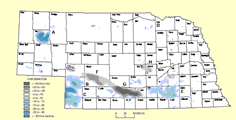Natural Resources, School of
Date of this Version
3-10-2017
Citation
Hallum, Douglas and Susan Lackey. 2017. Results of Test-Hole Drilling for Observation Well Planning in the Upper Loup Natural Resources District, Fall 2016. North Platte, NE: Conservation and Survey Division, University of Nebraska - Lincoln. PP. 33
Abstract
The High Plains Aquifer underlies much of Nebraska (Figure 1). It is the primary source of groundwater within the Upper Loup Natural Resources District (ULNRD) of central Nebraska (Figure 2). Water derived from the aquifer is an important natural resource for the area and supplies water for recreation, wildlife and agriculture, as well as domestic, municipal, and industrial uses. A general lack of water level observations in the region (Figure 3), recently developed groundwater irrigated acres along the upper Calamus River (Figure 4), falling spring water levels measured in existing irrigation wells (Figure 5), and a stable to falling stream gage since 2010 on the Calamus River near Harrup (Figure 6) have raised concerns about possible changes in water availability, groundwater-surface water relationships and water quality in the area, prompting the ULNRD to propose collection of baseline data in the region.
The Conservation and Survey Division (CSD) was enlisted by the ULNRD to conduct a test-hole drilling study of the area. The purpose of this study was to obtain hydrogeological data that would assist the ULNRD with the planning, placement, and design of observation wells in southern Brown and eastern Blaine Counties. Four priority areas were selected to increase the spatial density of CSD test holes and NRD monitoring wells to better identify conditions along the Calamus and North Loup Rivers. Three test holes were drilled between September 27 and October 13, 2016. Hydrogeological data collected from the test holes supplied information from which observation well specifications were derived. As a result, observation wells were constructed in October 2016. . Additionally, this study provided training to ULNRD staff on procedures for test-hole drilling and the design and placement of future observation wells.
Included in
Geology Commons, Geomorphology Commons, Hydrology Commons, Paleontology Commons, Sedimentology Commons, Soil Science Commons, Stratigraphy Commons


Comments
OFR-152